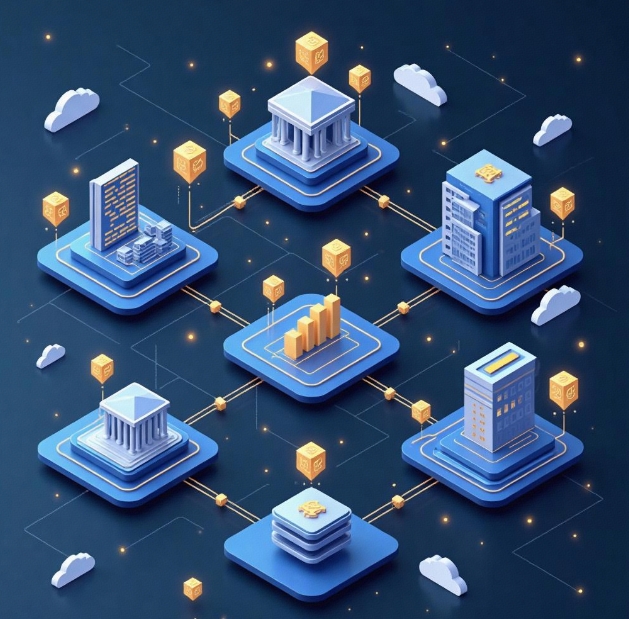Decentralized Finance in Web3 Development: Core Concepts and Applications of DeFi
- latest articles
- 1.DApp Development & Customization: Merging Diverse Market Needs with User Experience 2.Analysis of the Core Technical System in DApp Project Development 3.How to achieve cross-chain interoperability in Web3 projects? 4.How does the tokenization of points reconstruct the e-commerce ecosystem? 5.How to Set and Track Data Metrics for a Points Mall? 6.What is DApp Development? Core Concepts and Technical Analysis 7.Inventory of commonly used Web3 development tools and usage tips 8.Development of a Distribution System Integrated with Social E-commerce 9.Six Key Steps for Businesses to Build a Points Mall System 10.What is DApp Development? A Comprehensive Guide from Concept to Implementation
- Popular Articles
- 1.Future Trends and Technology Predictions for APP Development in 2025 2.Analysis of the DeFi Ecosystem: How Developers Can Participate in Decentralized Finance Innovation 3.From Zero to One: How PI Mall Revolutionizes the Traditional E-commerce Model 4.DAPP Development | Best Practices for Professional Customization and Rapid Launch 5.Recommended by the Web3 developer community: the most noteworthy forums and resources 6.From Cloud Computing to Computing Power Leasing: Building a Flexible and Scalable Computing Resource Platform 7.How to Develop a Successful Douyin Mini Program: Technical Architecture and Best Practices 8.Shared Bike System APP: The Convenient Choice in the Era of Smart Travel 9.How to Create a Successful Dating App: From Needs Analysis to User Experience Design 10.From Design to Development: The Complete Process of Bringing an APP Idea to Life
With the rapid development of blockchain technology, Web3, as an emerging internet architecture model, has gradually attracted the attention of global developers, investors, and entrepreneurs. The core concept of Web3 is decentralization, aiming to return control of data, services, and applications to users by eliminating centralized entities in the traditional internet. In the development process of Web3, Decentralized Finance (DeFi), as an important component, is gradually changing the structure and operation of the traditional financial industry. This article will delve into the core concepts, technical implementation, and application of Decentralized Finance (DeFi) in Web3 development, analyzing its potential impact on the financial system and socio-economy.
I. Core Concepts of DeFi
Decentralized Finance (DeFi) is a financial system built on blockchain technology that allows users to conduct financial activities such as transactions, lending, and asset exchanges without intermediaries through smart contracts and decentralized protocols. Compared to the traditional financial system, DeFi is characterized by decentralization, openness, transparency, and borderlessness. Its core concepts can be summarized as follows:
1. Decentralization
In the traditional financial system, transactions and services typically rely on central institutions such as banks, securities companies, and insurance companies, which act as intermediaries for financial services. The core of DeFi lies in decentralization, where blockchain technology enables financial services and products to be provided without relying on traditional financial institutions. All financial activities, including transactions, asset management, and lending, are automatically executed through smart contracts, eliminating the need for intermediaries. This decentralized structure not only improves efficiency but also reduces costs and risks.
2. Openness
DeFi protocols and platforms are typically open-source, allowing anyone to view, use, modify, or even contribute to the code. This openness enables any developer or user to participate in the DeFi ecosystem, regardless of their location. The openness of DeFi also means that no institution or individual can control the entire system, making it more transparent and fair.
3. Transparency
The inherent transparency of blockchain technology is the foundation of DeFi systems. All transaction records and smart contract codes are stored on the blockchain, and anyone can view transaction histories and contract execution details. This transparency makes DeFi platforms and protocols more trustworthy, allowing users to verify the authenticity and compliance of transactions in real-time.
4. User Self-Management
In DeFi systems, users no longer rely on centralized institutions like banks to manage their assets. Instead, users control their funds and data through private keys. This self-management model grants users more rights and freedom but also requires them to possess certain technical skills and security awareness to prevent loss or theft of funds.
5. Borderlessness
The traditional financial system is often constrained by national and regional policies, such as complex cross-border payment procedures and significant exchange rate fluctuations. In contrast, DeFi platforms typically have no geographical or political restrictions, allowing users to conduct transactions and investments freely worldwide. The borderless nature of decentralized finance greatly promotes global financial integration, especially in developing countries and regions, where DeFi provides more opportunities for financial participation.
II. Key Technologies of DeFi
The implementation of DeFi relies on various blockchain technologies, particularly smart contracts, decentralized exchanges (DEX), stablecoins, and decentralized lending platforms. Below are some key technologies in DeFi applications:
1. Smart Contracts
Smart contracts are the core of DeFi protocols; they are automated, immutable contracts. Based on blockchain technology, smart contracts can execute agreement terms without third-party intermediaries. In DeFi platforms, smart contracts are commonly used for asset exchanges, lending, collateralization, and other operations. When users transact through smart contracts, the contracts automatically execute according to predefined rules, ensuring fairness and transparency in transactions.
2. Decentralized Exchanges (DEX)
Decentralized exchanges (DEX) are a crucial component of the DeFi ecosystem. Unlike traditional centralized exchanges, DEXs have no single administrator or controller. Transactions occur directly between users, with matching, clearing, and settlement handled automatically by smart contracts. This decentralized approach not only enhances transaction transparency and security but also reduces transaction costs and fees. Common DEXs include Uniswap and SushiSwap.
3. Stablecoins
Stablecoins are a type of cryptocurrency commonly used in DeFi systems, with their value typically pegged to fiat currencies (such as the US dollar or euro) to maintain relative stability. The introduction of stablecoins addresses the issue of high price volatility in cryptocurrencies, enabling DeFi protocols to better provide financial services like lending and payments. Common stablecoins include Tether (USDT), USD Coin (USDC), and Dai.
4. Decentralized Lending Platforms
Decentralized lending platforms are another important part of DeFi applications, allowing users to lend and borrow without intermediaries. Through these platforms, borrowers can obtain loans by collateralizing crypto assets, while lenders earn interest by providing funds. Loan interest rates, terms, and other conditions are typically predefined by smart contracts, ensuring fairness and automated execution. Aave, Compound, and MakerDAO are well-known decentralized lending platforms in the current market.
III. Application Scenarios of DeFi
DeFi has a wide range of application scenarios, covering various aspects of traditional finance. Below are some of the main application scenarios of DeFi:
1. Decentralized Trading (DEX)
Decentralized exchanges are one of the earliest and most important applications of DeFi. Through DEXs, users can directly trade cryptocurrencies without relying on centralized trading platforms. DEXs not only provide a freer, more transparent, and secure trading environment but also avoid potential security vulnerabilities and fund theft risks associated with exchanges.
2. Decentralized Lending
The decentralized lending function of DeFi platforms allows users to conduct borrowing operations without traditional banks. Borrowers can use cryptocurrencies as collateral to obtain loans from decentralized platforms, while lenders earn interest by providing funds. This approach breaks down credit barriers in traditional finance, enabling ordinary users to participate in financial activities.
3. Stablecoin Payments
Due to the high price volatility of cryptocurrencies, the introduction of stablecoins makes digital currency payments more stable and practical. Through stablecoins, users can achieve global payments and transfers without worrying about exchange rate fluctuations. DeFi platforms provide cross-border payment and micro-payment services via stablecoins, reducing payment fees and improving payment efficiency.
4. Decentralized Asset Management
DeFi platforms also offer decentralized asset management services, allowing users to autonomously manage their digital assets, including cryptocurrencies and NFTs (Non-Fungible Tokens). Through smart contracts, users can automate asset management according to specific investment strategies, performing asset allocation and risk control. This decentralized asset management approach provides more flexible and personalized investment options.
5. Decentralized Insurance
Decentralized insurance is an innovation in DeFi applications, allowing users to purchase insurance through smart contracts and receive automatic payouts when insured events occur. Leveraging the decentralized nature of blockchain technology, decentralized insurance reduces fraud and moral hazards in the insurance industry while improving payout efficiency.
IV. Challenges and Future Development of DeFi
Although DeFi brings many innovations and opportunities, it also faces a series of challenges and risks:
1. Security
While smart contracts in DeFi platforms offer automation and decentralization advantages, their code may contain vulnerabilities or security flaws. If a smart contract has a vulnerability, it could lead to theft or loss of user assets. DeFi projects need to enhance smart contract auditing and security testing to ensure platform security.
2. Regulatory Compliance
The decentralized nature of DeFi creates conflicts with regulatory frameworks in the traditional financial system. Different countries and regions have varying regulatory policies for cryptocurrencies and DeFi, introducing uncertainty to its development. Achieving compliance on a decentralized basis is a significant challenge for DeFi's growth.
3. User Education
Due to the operational complexity of DeFi platforms, users need certain technical skills and financial knowledge to participate in DeFi applications. This requires DeFi projects to invest more resources in user education, helping users understand the basic concepts and operations of decentralized finance.
4. Scalability
Currently, blockchain scalability remains a bottleneck for DeFi. As user numbers and transaction volumes increase, blockchain networks may face congestion and high transaction fees. Improving blockchain processing capacity to support the rapid development of DeFi is a key issue for its future growth.
V. Conclusion
Decentralized Finance (DeFi) is one of the most disruptive and innovative fields in the Web3 ecosystem. Through blockchain technology, it breaks the limitations of the traditional financial system, offering more open, transparent, and efficient financial services. Although DeFi faces challenges in security, regulatory compliance, and user education, with continuous technological advancements and gradual regulatory improvements, its application scenarios will become more extensive, potentially occupying an important position in the global financial system in the future. Driven by Web3, DeFi will continue to promote the decentralized transformation of global finance, bringing more opportunities and challenges to users and developers worldwide.
-

How to achieve cross-chain interoperability in Web3 projects?
With the continuous development of WEB3 technology, Web3 has gradually become an···
-

Inventory of commonly used Web3 development tools and usage tips
With the continuous development of blockchain technology, Web3 has become a hot ···
-

Web3 development trend prediction: analysis of future technology directions and application scenarios
With the gradual development of blockchain technology, the concept of Web3 has m···

 Blockchain
Blockchain












